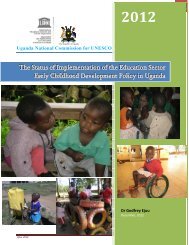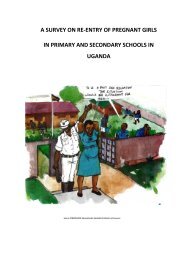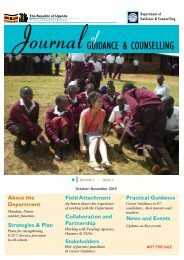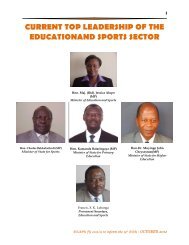Download Pdf - Ministry of Education and Sports
Download Pdf - Ministry of Education and Sports
Download Pdf - Ministry of Education and Sports
Create successful ePaper yourself
Turn your PDF publications into a flip-book with our unique Google optimized e-Paper software.
In the FY 2010/11, the total number <strong>of</strong> classrooms in all primary schools was 142,802, <strong>and</strong> by June<br />
2011/12, the number <strong>of</strong> classrooms had increased by 1.2% to the tune <strong>of</strong> 144,513 classrooms.<br />
Consequently, the pupil class ratio was maintained at 54 in FY 2011/12.<br />
(iv) Gender Parity in Primary Schools<br />
School access programs in the sector aim at reducing the gap between boys <strong>and</strong> girls in education so<br />
as to promote equality in lifelong opportunities. The programmes are intended to ensure that both<br />
boys <strong>and</strong> girls leave the school system with an education or vocational training according to their<br />
capabilities <strong>and</strong> free from gender categorization. Evidence available shows that the proportion <strong>of</strong> girls<br />
enrolling in school has increased in Ug<strong>and</strong>a. Enrolment <strong>of</strong> girls <strong>and</strong> boys at primary school level has<br />
reached the parity level. During the period under review, a total <strong>of</strong> 8,317,420 (Male 4,161,057; female<br />
4,156,363) pupils were enrolled in primary schools <strong>of</strong> which 50% were female. For the last two<br />
financial years, more girls were enrolled in school as compared to the boys. This indicates progress as<br />
far as educating the girl child is concerned. See table 4.6.<br />
Table: 4.6.Percentage share <strong>of</strong> pupils by gender<br />
FY 2010/11 2011/12<br />
Female 50.1% 50.0%<br />
Male 49.9% 50.0%<br />
Source: EMIS 2011/12<br />
43<br />
(d)<br />
Constraints/Challenges<br />
Some <strong>of</strong> the key barriers to enhancing equitable access in the basic education subsector include the<br />
following;<br />
(i)<br />
(ii)<br />
(iii)<br />
(iv)<br />
(v)<br />
(vi)<br />
Absenteeism <strong>of</strong> teachers <strong>and</strong> pupils is crippling the Universal Primary <strong>Education</strong> (UPE)<br />
Programmes;<br />
Seven thous<strong>and</strong> shillings per child per year is no longer adequate considering the cost <strong>of</strong><br />
living. It should be raised to atleast ten thous<strong>and</strong> shillings per child per year;<br />
Funds allocated under SFG/PRDP civil works are far below the need for construction <strong>of</strong><br />
classrooms, teachers’ houses, <strong>and</strong> pit latrines;<br />
Insufficient teaching <strong>and</strong> learning materials;<br />
Majority <strong>of</strong> teachers commute from very far due to inadequate teachers’ houses; <strong>and</strong>,<br />
There is a ban on grant aiding schools yet the dem<strong>and</strong> is very high.<br />
4.1.2 Secondary <strong>Education</strong><br />
Secondary education has experienced tremendous growth during the past decade. The introduction <strong>of</strong><br />
Universal Secondary <strong>Education</strong> in 2007 resulted into increased enrolment to 1,106,000 in both<br />
government <strong>and</strong> private secondary schools (EMIS – 2011). However, in order to facilitate the students’<br />
development <strong>of</strong> knowledge <strong>and</strong> an underst<strong>and</strong>ing <strong>of</strong> the various emerging needs <strong>of</strong> society <strong>and</strong> the<br />
economy, the secondary education subsector, has come up with a number <strong>of</strong> policy objectives for FY<br />
2011/12 that include: to increase access <strong>and</strong> equity <strong>of</strong> secondary education; improving quality <strong>of</strong><br />
secondary education; enhancing efficiency <strong>and</strong> effectiveness in the delivery <strong>of</strong> secondary education<br />
ESSAPR FY 2011/12 to inform the 19 th ESSR – OCTOBER 2012








